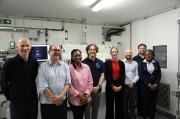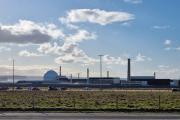UKAEA Short-Lists Four Beach Monitoring Sytems
1st August 2006

A worldwide search for technology capable of improving UKAEA's detection of radioactive particles on beaches near Dounreay has resulted in four companies being short-listed for the award of a contract to undertake the work.
Four different systems, including an enhanced version of the system currently in use, were selected by a panel of experts after a series of trials to test their performance against the current system.
The companies will now be invited to tender for the contract to monitor local beaches when it comes up for renewal next year.
Dr Joe Toole, UKAEA's particles monitoring programme manager, said: "When we last awarded the contract in 2002, the system we selected was the best that was made available to us during the competitive tendering process. But a number of stakeholders expressed the view that other technology could be developed that would improve our detection abilities.
"I am very pleased that we have been able to work with these stakeholders to identify and test other systems. We are now in a position to take forward four different systems with a view to choosing the one that can best meet the current and future regulatory requirements of the Scottish Environment Protection Agency."
UKAEA established its Beaches Monitoring Steering Group, composed of radiometrics experts, in 2003 to undertake the research programme.
In 2004, 13 companies from around the world expressed an interest in offering their systems in response to a notice placed in the Official Journal of the European Union. Seven were selected for testing, and six companies proceeded to the trials stage.
A simulated beach was constructed at the UKAEA site at Harwell in Oxfordshire, with radioactive sources buried in the sand. The sources varied in activity and included both caesium-137 and cobalt-60 sources. Approximately 5000 test runs over the beach were made using the six different systems and the results compared against the performance of the existing system.
The expert members of the working group have now short-listed four systems that will proceed to the tender stage for a three-year contract.
Related Businesses
Related Articles
UKAEA develops 3D printing for fusion components
At its recently opened Central Support Facility (CSF), UKAEA has commissioned an electron beam additive manufacturing machine that can be used to incorporate tungsten into components, alongside a selective laser manufacturing machine. Fusion can play a key role in a global low carbon energy future.Advancing Fusion Remote Maintenance: Industry Collaboration Driving Innovation
As part of the Fusion Futures (FF) programme, UKAEA's Remote Applications in Challenging Environments (RACE) has partnered with industry leaders to develop two groundbreaking technologies for remote maintenance in fusion energy engineering. Thanks to FF funding, industry has taken the lead in maturing UKAEA technology concepts—delivering real-world solutions that enhance operational autonomy and reduce maintenance burdens in extreme environments.UKAEA launches International Fellowships Scheme for fusion
UKAEA has launched the International Fellowships Scheme, an initiative to help expand the global talent pool supporting the fusion industry. The scheme is part of the UKAEA's Fusion Opportunities in Skills, Training, Education and Research (FOSTER) Programme, which aims to train, support, and empower the next generation of professionals, who will help deliver fusion power to the grid.Kyoto Fusioneering and Astral Systems join Culham fusion hub
UKAEA's Culham Campus welcomes Kyoto Fusioneering and Astral Systems as its latest tenants. Two pioneering companies, Kyoto Fusioneering and Astral Systems, have joined the growing cluster of fusion technology and AI organisations at United Kingdom Atomic Energy Authority's (UKAEA) Culham Campus.
Fusion-grade Steel Produced At Scale In UK-first
Researchers achieve 10x production cost savings for reduced activation steel. A United Kingdom Atomic Energy Authority (UKAEA) working group has successfully demonstrated the industrial scale production of fusion-grade steel.
UKAEA To Lead The Creation Of A Robotics And AI Cluster
UKAEA will lead the creation of a new £4.9m nuclear robotics and artificial intelligence cluster across Cumbria and Oxfordshire. The robotics and AI cluster was announced by UK Research and Innovation (UKRI) as one of seven new projects to kickstart economic growth and address regional needs: www.ukri.org The robotics and AI cluster will link Cumbria and Oxfordshire to accelerate the decommissioning of the UK's legacy nuclear fission facilities and keep people out of hazardous environments.
Diamonds Are Forever? World-first Carbon-14 Diamond Battery Made In Uk
The world's first carbon-14 diamond has been produced with the potential to provide power for thousands of years. Scientists and engineers from the UK Atomic Energy Authority (UKAEA) and the University of Bristol have successfully created the world's first carbon-14 diamond battery.
UKAEA Monthly Newsletter Latest Edition
Find out what has been happening at UKAEA in our monthly newsletter. Read about our recent activities and upcoming events.
UKAEA Newsletter - Edition 11 Published Today
Find out what has been happening at UKAEA in our monthly newsletter. Read about our recent activities and upcoming events.
Corwm Visits Dounreay Nuclear Site
Members were given an overview of the scale of the problem and challenges faced in the decommissioning of the site. In the last week of March 2024, several members of CoRWM led by the Chair, Sir Nigel Thrift, made the long journey up to the North of Scotland to visit the Dounreay nuclear site, now managed by Nuclear Restoration Services.
